service indicator GMC CANYON 2020 User Guide
[x] Cancel search | Manufacturer: GMC, Model Year: 2020, Model line: CANYON, Model: GMC CANYON 2020Pages: 364, PDF Size: 5.59 MB
Page 114 of 364

GMC Canyon/Canyon Denali Owner Manual (GMNA-Localizing-U.S./Canada-
13566643) - 2020 - CRC - 10/4/19
Instruments and Controls 113
Low Fuel Warning Light
(Base Level)
English Shown
This light comes on for a few
seconds when the ignition is turned
on as a check to indicate it is
working. If it does not come on,
have it fixed.
The low fuel warning light comes on
and a chime sounds when the
vehicle is low on fuel. The light turns
off when fuel is added to the
fuel tank.
Low Fuel Warning Light
(Uplevel)
This light is near the fuel gauge and
comes on briefly when the ignition is
turned on as a check to show it is
working.
It also comes on when the fuel tank
is low on fuel. The light turns off
when fuel is added. If it does not,
have the vehicle serviced.
Security Light
The security light should come on
briefly as the engine is started. If it
does not come on, have the vehicle
serviced by your dealer. If the
system is working normally, the
indicator light turns off.
If the light stays on and the engine
does not start, there could be a
problem with the theft-deterrent
system. See Immobilizer Operation
0 20.
High-Beam On Light
This light comes on when the
high-beam headlamps are in use.
See Headlamp High/Low-Beam
Changer 0126.
Page 164 of 364
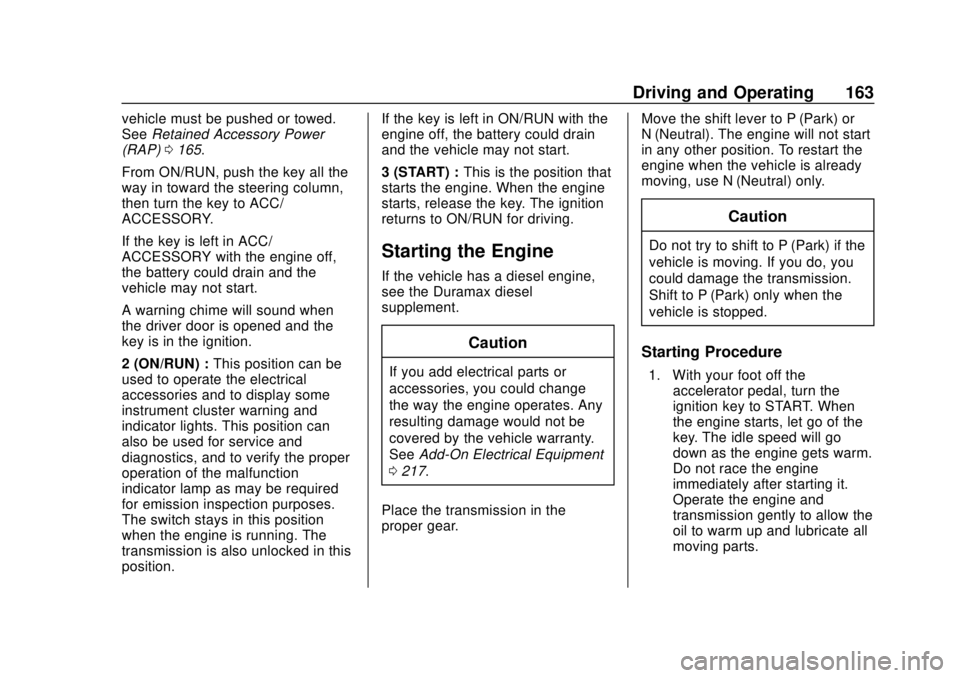
GMC Canyon/Canyon Denali Owner Manual (GMNA-Localizing-U.S./Canada-
13566643) - 2020 - CRC - 10/4/19
Driving and Operating 163
vehicle must be pushed or towed.
SeeRetained Accessory Power
(RAP) 0165.
From ON/RUN, push the key all the
way in toward the steering column,
then turn the key to ACC/
ACCESSORY.
If the key is left in ACC/
ACCESSORY with the engine off,
the battery could drain and the
vehicle may not start.
A warning chime will sound when
the driver door is opened and the
key is in the ignition.
2 (ON/RUN) : This position can be
used to operate the electrical
accessories and to display some
instrument cluster warning and
indicator lights. This position can
also be used for service and
diagnostics, and to verify the proper
operation of the malfunction
indicator lamp as may be required
for emission inspection purposes.
The switch stays in this position
when the engine is running. The
transmission is also unlocked in this
position. If the key is left in ON/RUN with the
engine off, the battery could drain
and the vehicle may not start.
3 (START) :
This is the position that
starts the engine. When the engine
starts, release the key. The ignition
returns to ON/RUN for driving.
Starting the Engine
If the vehicle has a diesel engine,
see the Duramax diesel
supplement.
Caution
If you add electrical parts or
accessories, you could change
the way the engine operates. Any
resulting damage would not be
covered by the vehicle warranty.
See Add-On Electrical Equipment
0 217.
Place the transmission in the
proper gear. Move the shift lever to P (Park) or
N (Neutral). The engine will not start
in any other position. To restart the
engine when the vehicle is already
moving, use N (Neutral) only.
Caution
Do not try to shift to P (Park) if the
vehicle is moving. If you do, you
could damage the transmission.
Shift to P (Park) only when the
vehicle is stopped.
Starting Procedure
1. With your foot off the
accelerator pedal, turn the
ignition key to START. When
the engine starts, let go of the
key. The idle speed will go
down as the engine gets warm.
Do not race the engine
immediately after starting it.
Operate the engine and
transmission gently to allow the
oil to warm up and lubricate all
moving parts.
Page 195 of 364
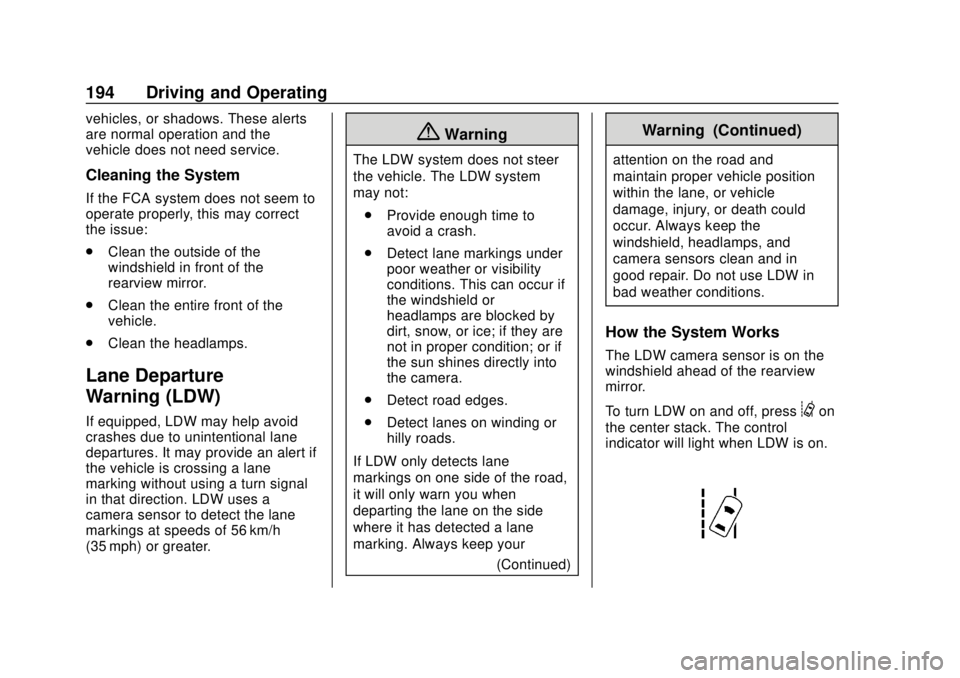
GMC Canyon/Canyon Denali Owner Manual (GMNA-Localizing-U.S./Canada-
13566643) - 2020 - CRC - 10/4/19
194 Driving and Operating
vehicles, or shadows. These alerts
are normal operation and the
vehicle does not need service.
Cleaning the System
If the FCA system does not seem to
operate properly, this may correct
the issue:
.Clean the outside of the
windshield in front of the
rearview mirror.
. Clean the entire front of the
vehicle.
. Clean the headlamps.
Lane Departure
Warning (LDW)
If equipped, LDW may help avoid
crashes due to unintentional lane
departures. It may provide an alert if
the vehicle is crossing a lane
marking without using a turn signal
in that direction. LDW uses a
camera sensor to detect the lane
markings at speeds of 56 km/h
(35 mph) or greater.
{Warning
The LDW system does not steer
the vehicle. The LDW system
may not:
. Provide enough time to
avoid a crash.
. Detect lane markings under
poor weather or visibility
conditions. This can occur if
the windshield or
headlamps are blocked by
dirt, snow, or ice; if they are
not in proper condition; or if
the sun shines directly into
the camera.
. Detect road edges.
. Detect lanes on winding or
hilly roads.
If LDW only detects lane
markings on one side of the road,
it will only warn you when
departing the lane on the side
where it has detected a lane
marking. Always keep your (Continued)
Warning (Continued)
attention on the road and
maintain proper vehicle position
within the lane, or vehicle
damage, injury, or death could
occur. Always keep the
windshield, headlamps, and
camera sensors clean and in
good repair. Do not use LDW in
bad weather conditions.
How the System Works
The LDW camera sensor is on the
windshield ahead of the rearview
mirror.
To turn LDW on and off, press
@on
the center stack. The control
indicator will light when LDW is on.
Page 218 of 364
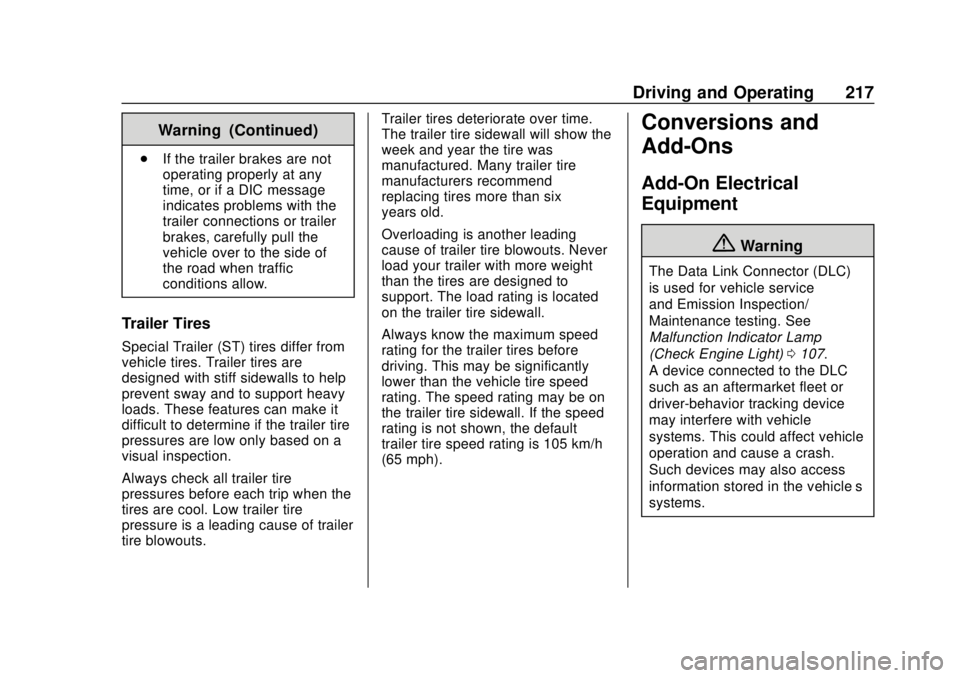
GMC Canyon/Canyon Denali Owner Manual (GMNA-Localizing-U.S./Canada-
13566643) - 2020 - CRC - 10/4/19
Driving and Operating 217
Warning (Continued)
.If the trailer brakes are not
operating properly at any
time, or if a DIC message
indicates problems with the
trailer connections or trailer
brakes, carefully pull the
vehicle over to the side of
the road when traffic
conditions allow.
Trailer Tires
Special Trailer (ST) tires differ from
vehicle tires. Trailer tires are
designed with stiff sidewalls to help
prevent sway and to support heavy
loads. These features can make it
difficult to determine if the trailer tire
pressures are low only based on a
visual inspection.
Always check all trailer tire
pressures before each trip when the
tires are cool. Low trailer tire
pressure is a leading cause of trailer
tire blowouts. Trailer tires deteriorate over time.
The trailer tire sidewall will show the
week and year the tire was
manufactured. Many trailer tire
manufacturers recommend
replacing tires more than six
years old.
Overloading is another leading
cause of trailer tire blowouts. Never
load your trailer with more weight
than the tires are designed to
support. The load rating is located
on the trailer tire sidewall.
Always know the maximum speed
rating for the trailer tires before
driving. This may be significantly
lower than the vehicle tire speed
rating. The speed rating may be on
the trailer tire sidewall. If the speed
rating is not shown, the default
trailer tire speed rating is 105 km/h
(65 mph).
Conversions and
Add-Ons
Add-On Electrical
Equipment
{Warning
The Data Link Connector (DLC)
is used for vehicle service
and Emission Inspection/
Maintenance testing. See
Malfunction Indicator Lamp
(Check Engine Light)
0107.
A device connected to the DLC —
such as an aftermarket fleet or
driver-behavior tracking device —
may interfere with vehicle
systems. This could affect vehicle
operation and cause a crash.
Such devices may also access
information stored in the vehicle’s
systems.
Page 240 of 364
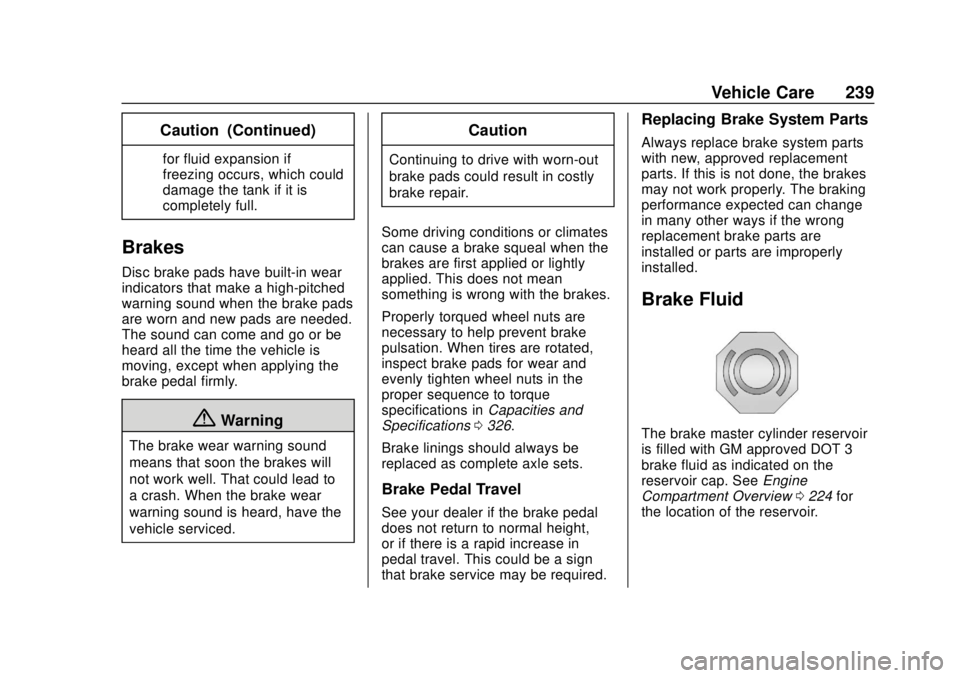
GMC Canyon/Canyon Denali Owner Manual (GMNA-Localizing-U.S./Canada-
13566643) - 2020 - CRC - 10/4/19
Vehicle Care 239
Caution (Continued)
for fluid expansion if
freezing occurs, which could
damage the tank if it is
completely full.
Brakes
Disc brake pads have built-in wear
indicators that make a high-pitched
warning sound when the brake pads
are worn and new pads are needed.
The sound can come and go or be
heard all the time the vehicle is
moving, except when applying the
brake pedal firmly.
{Warning
The brake wear warning sound
means that soon the brakes will
not work well. That could lead to
a crash. When the brake wear
warning sound is heard, have the
vehicle serviced.
Caution
Continuing to drive with worn-out
brake pads could result in costly
brake repair.
Some driving conditions or climates
can cause a brake squeal when the
brakes are first applied or lightly
applied. This does not mean
something is wrong with the brakes.
Properly torqued wheel nuts are
necessary to help prevent brake
pulsation. When tires are rotated,
inspect brake pads for wear and
evenly tighten wheel nuts in the
proper sequence to torque
specifications in Capacities and
Specifications 0326.
Brake linings should always be
replaced as complete axle sets.
Brake Pedal Travel
See your dealer if the brake pedal
does not return to normal height,
or if there is a rapid increase in
pedal travel. This could be a sign
that brake service may be required.
Replacing Brake System Parts
Always replace brake system parts
with new, approved replacement
parts. If this is not done, the brakes
may not work properly. The braking
performance expected can change
in many other ways if the wrong
replacement brake parts are
installed or parts are improperly
installed.
Brake Fluid
The brake master cylinder reservoir
is filled with GM approved DOT 3
brake fluid as indicated on the
reservoir cap. See Engine
Compartment Overview 0224 for
the location of the reservoir.
Page 320 of 364
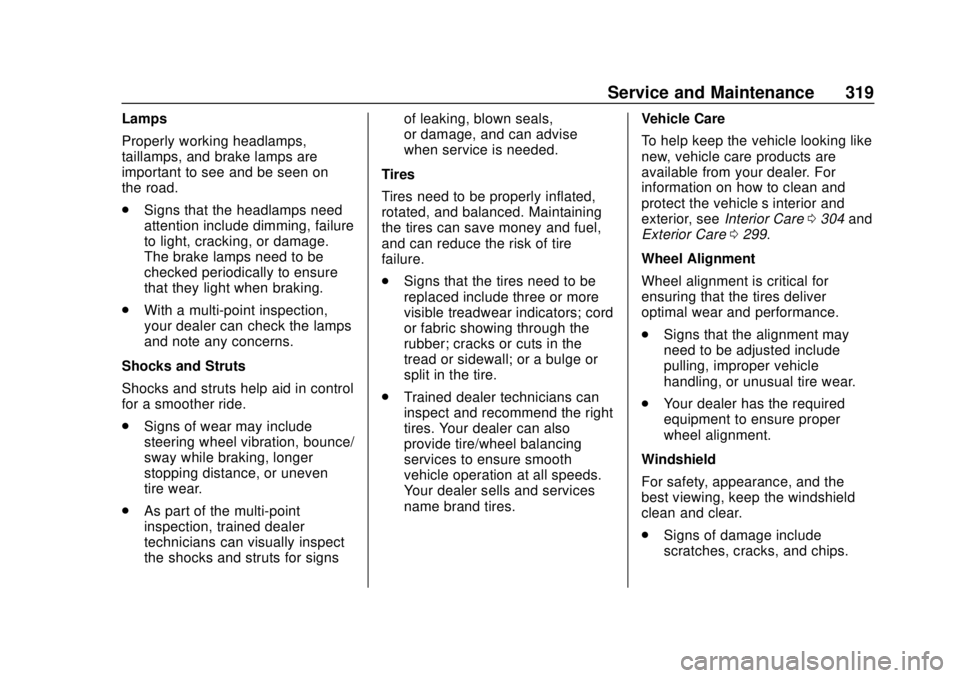
GMC Canyon/Canyon Denali Owner Manual (GMNA-Localizing-U.S./Canada-
13566643) - 2020 - CRC - 10/4/19
Service and Maintenance 319
Lamps
Properly working headlamps,
taillamps, and brake lamps are
important to see and be seen on
the road.
.Signs that the headlamps need
attention include dimming, failure
to light, cracking, or damage.
The brake lamps need to be
checked periodically to ensure
that they light when braking.
. With a multi-point inspection,
your dealer can check the lamps
and note any concerns.
Shocks and Struts
Shocks and struts help aid in control
for a smoother ride.
. Signs of wear may include
steering wheel vibration, bounce/
sway while braking, longer
stopping distance, or uneven
tire wear.
. As part of the multi-point
inspection, trained dealer
technicians can visually inspect
the shocks and struts for signs of leaking, blown seals,
or damage, and can advise
when service is needed.
Tires
Tires need to be properly inflated,
rotated, and balanced. Maintaining
the tires can save money and fuel,
and can reduce the risk of tire
failure.
. Signs that the tires need to be
replaced include three or more
visible treadwear indicators; cord
or fabric showing through the
rubber; cracks or cuts in the
tread or sidewall; or a bulge or
split in the tire.
. Trained dealer technicians can
inspect and recommend the right
tires. Your dealer can also
provide tire/wheel balancing
services to ensure smooth
vehicle operation at all speeds.
Your dealer sells and services
name brand tires. Vehicle Care
To help keep the vehicle looking like
new, vehicle care products are
available from your dealer. For
information on how to clean and
protect the vehicle’s interior and
exterior, see
Interior Care 0304 and
Exterior Care 0299.
Wheel Alignment
Wheel alignment is critical for
ensuring that the tires deliver
optimal wear and performance.
. Signs that the alignment may
need to be adjusted include
pulling, improper vehicle
handling, or unusual tire wear.
. Your dealer has the required
equipment to ensure proper
wheel alignment.
Windshield
For safety, appearance, and the
best viewing, keep the windshield
clean and clear.
. Signs of damage include
scratches, cracks, and chips.
Page 357 of 364

GMC Canyon/Canyon Denali Owner Manual (GMNA-Localizing-U.S./Canada-
13566643) - 2020 - CRC - 10/4/19
356 Index
Fuel (cont'd)Recommended . . . . . . . . . . . . . . . 196
Top Tier . . . . . . . . . . . . . . . . . . . . . . 195
Full-Size Spare Tire . . . . . . . . . . . . 290
Fuses Engine Compartment FuseBlock . . . . . . . . . . . . . . . . . . . . . . . . 250
Fuses and Circuit Breakers . . . 249
Instrument Panel Fuse Block . . . . . . . . . . . . . . . . . . . . . . . . 254
G
Gas Strut(s) . . . . . . . . . . . . . . . . . . . . 244
GaugesEngine CoolantTemperature . . . . . . . . . . . . . . . . 104
Fuel . . . . . . . . . . . . . . . . . . . . . . . . . . 103
Odometer . . . . . . . . . . . . . . . . . . . . . 102
Speedometer . . . . . . . . . . . . . . . . . 102
Tachometer . . . . . . . . . . . . . . . . . . . 102
Trip Odometer . . . . . . . . . . . . . . . . 102
Warning Lights and
Indicators . . . . . . . . . . . . . . . . . . . . . 97
General Information Service and Maintenance . . . . . 309
Towing . . . . . . . . . . . . . . . . . . . . . . . . 199
Vehicle Care . . . . . . . . . . . . . . . . . . 220
Glove Box . . . . . . . . . . . . . . . . . . . . . . . 88 GM Mobility Reimbursement
Program . . . . . . . . . . . . . . . . . . . . . . . 332
H
Halogen Bulbs . . . . . . . . . . . . . . . . . . 246
Hazard Warning Flashers . . . . . . . 128
Head Restraints . . . . . . . . . . . . . . . . . 28
Headlamps
Aiming . . . . . . . . . . . . . . . . . . . . . . . . 246
Automatic . . . . . . . . . . . . . . . . . . . . . 127
Bulb Replacement . . . . . . . . . . . . 246
Daytime RunningLamps (DRL) . . . . . . . . . . . . . . . . 127
Flash-to-Pass . . . . . . . . . . . . . . . . . 126
Headlamps, Front Turn Signal, Sidemarker, and
Parking Lamps . . . . . . . . . . . . . . 246
High-Beam On Light . . . . . . . . . . .113
High/Low Beam Changer . . . . . 126
Lamps On Reminder . . . . . . . . . .114
Heated
Steering Wheel . . . . . . . . . . . . . . . . . 91
Heated and Ventilated Front Seats . . . . . . . . . . . . . . . . . . . . . . . . . . 32
Heated Mirrors . . . . . . . . . . . . . . . . . . . 22
Heater Engine . . . . . . . . . . . . . . . . . . . . . . . . 164
Heating . . . . . . . . . . . . . . . . . . . . 134, 136 High-Beam On Light . . . . . . . . . . . . 113
Hill and Mountain Roads . . . . . . . . 151
Hill Descent Control (HDC) . . . . . 184
Hill Descent Control Light . . . . . . . 110
Hill Start Assist (HSA) . . . . . . . . . . 182
Hood . . . . . . . . . . . . . . . . . . . . . . . . . . . 222
Horn . . . . . . . . . . . . . . . . . . . . . . . . . . . . . 92
How to Wear Seat Belts
Properly . . . . . . . . . . . . . . . . . . . . . . . . 37
HVAC . . . . . . . . . . . . . . . . . . . . . . 134, 136
I
Ignition Positions . . . . . . . . . . . . . . . 161
Ignition Transmission Lock Check . . . . . . . . . . . . . . . . . . . . . . . . . 243
Immobilizer . . . . . . . . . . . . . . . . . . . . . . 20
Indicator Vehicle Ahead . . . . . . . . . . . . . . . . .110
Infants and Young Children, Restraints . . . . . . . . . . . . . . . . . . . . . . 58
Information
Publication Ordering . . . . . . . . . . 338
Infotainment . . . . . . . . . . . . . . . . . . . . 133
Infotainment System . . . . . . . . . . . . 342
Instrument Cluster . . . . . . . . . . 98, 100
Instrument Panel Overview . . . . . . . 5
Interior Rearview Mirrors . . . . . . . . . 23
Introduction . . . . . . . . . . . . . . . . . . . . . . . 2
Page 359 of 364

GMC Canyon/Canyon Denali Owner Manual (GMNA-Localizing-U.S./Canada-
13566643) - 2020 - CRC - 10/4/19
358 Index
M
MaintenanceRecords . . . . . . . . . . . . . . . . . . . . . . 324
Maintenance and Care Additional . . . . . . . . . . . . . . . . . . . . . 318
Maintenance Schedule . . . . . . . . . 311 Recommended Fluids andLubricants . . . . . . . . . . . . . . . . . . . 321
Transfer Case . . . . . . . . . . . . . . . . 174
Malfunction Indicator Lamp . . . . . 107
Manual Mirrors . . . . . . . . . . . . . . . . . . 21
Manual Mode . . . . . . . . . . . . . . . . . . . 172
Messages Engine Power . . . . . . . . . . . . . . . . 121
Vehicle . . . . . . . . . . . . . . . . . . . . . . . 121
Vehicle Speed . . . . . . . . . . . . . . . . 121
Mirrors Automatic DimmingRearview . . . . . . . . . . . . . . . . . . . . . . 24
Blind Spot . . . . . . . . . . . . . . . . . . . . . . 22
Convex . . . . . . . . . . . . . . . . . . . . . . . . . 21
Folding . . . . . . . . . . . . . . . . . . . . . . . . . 22
Heated . . . . . . . . . . . . . . . . . . . . . . . . . 22
Manual . . . . . . . . . . . . . . . . . . . . . . . . . 21
Manual Rearview . . . . . . . . . . . . . . . 23
Power . . . . . . . . . . . . . . . . . . . . . . . . . . 22
Mirrors, Interior Rearview . . . . . . . . 23 Monitor System, Tire
Pressure . . . . . . . . . . . . . . . . . . . . . . 265
N
Navigation
Connected Services . . . . . . . . . . 349
New Vehicle Break-In . . . . . . . . . . . 160
O
Odometer . . . . . . . . . . . . . . . . . . . . . . . 102
Trip . . . . . . . . . . . . . . . . . . . . . . . . . . . 102
Off-Road . . . . . . . . . . . . . . . . . . . . . . . 146 Driving . . . . . . . . . . . . . . . . . . . . . . . . 146
Recovery . . . . . . . . . . . . . . . . . . . . . 145
Oil Engine . . . . . . . . . . . . . . . . . . . . . . . . 227
Engine Oil Life System . . . . . . . 229
Pressure Light . . . . . . . . . . . . . . . . .112
Older Children, Restraints . . . . . . . 56
Online Owner Center . . . . . . . . . . . 332
OnStar . . . . . . . . . . . . . . . . . . . . . . . . . 342
OnStar Additional Information . . . . . . . . . . . . . . . . . . . . 345
OnStar Emergency . . . . . . . . . . . . . 344
OnStar Overview . . . . . . . . . . . . . . . 343
OnStar Security . . . . . . . . . . . . . . . . 345
Operation Fog Lamps . . . . . . . . . . . . . . . . . . . 129 Outlets
Power . . . . . . . . . . . . . . . . . . . . . . . . . . 93
Overheating, Engine . . . . . . . . . . . . 236
Overview Instrument Panel . . . . . . . . . . . . . . . . 5
P
ParkShifting Out of . . . . . . . . . . . . . . . . 167
Park Assist . . . . . . . . . . . . . . . . . . . . . 189
Parking Brake . . . . . . . . . . . . . . . . . . . . . . . . . 181
Brake and P (Park)
Mechanism Check . . . . . . . . . . 243
Over Things That Burn . . . . . . . 167
Parking or Backing Assistance Systems . . . . . . . . . . 189
Passenger Airbag Status Indicator . . . . . . . . . . . . . . . . . . . . . . 105
Passenger Compartment Air Filter . . . . . . . . . . . . . . . . . . . . . . . . . . 140
Passenger Sensing System . . . . . 50
Perchlorate Materials Requirements, California . . . . . . 221
Personalization Vehicle . . . . . . . . . . . . . . . . . . . . . . . 122
Power Door Locks . . . . . . . . . . . . . . . . . . . . . 17